In Focus: Thinking and Acting Circular
As the world’s population grows, so does demand for limited natural resources. At the same time, many recyclable materials end up in landfill or in waste incineration. New concepts are needed to decouple growth from resource consumption. Reduce, reuse and recycle are the keywords of this transition to a system of more sustainable product cycles with less resource consumption and lower carbon emissions.
The concept of conserving resources, recycling and feeding waste back into the system is not new for BASF. As early as 1865, it underpinned the foundation of our company: At that time, Friedrich Engelhorn pursued the idea of producing synthetic dyes from coal tar – a waste product – and organizing production efficiently in an integrated Verbund structure. We are still committed to this tradition today and are aligning our actions more strongly than ever with circularity. The chemical industry is doubly important for the transition to a circular economy. Firstly because many value chains start here. And secondly because many products and technologies based on chemistry help to close loops. That is why both aspects – switching to renewable raw materials and innovations for more circularity – are core elements of our Circular Economy Program.
For example, we already use bio-based and renewable raw materials in our production. To further reduce the resource and carbon footprints of our products and solutions, we will align our raw material base even more strongly toward recycled and renewable raw materials. For instance, we aim to process 250,000 metric tons of recycled and waste-based raw materials in our production plants annually from 2025. Together with partners, we are analyzing waste streams and raw material sources to find the best solution and develop suitable, innovative processes. This is the case, for example, in the chemical recycling of used tires and different types of plastics, where we can feed recovered raw materials such as pyrolysis oil or monomers back into our Verbund structure at different points. Another example is the recovery of valuable metals from spent batteries and catalytic converters.
In addition, we are developing innovative products and technologies in many areas that will increase the service life of materials or their recyclability and compostability. One example is additives for the mechanical recycling of plastics. A Group-wide co-funding program supports our employees in developing new business models for the circular economy – from the initial idea to market launch. Our target: By 2030, we want to double our sales of solutions for the circular economy to €17 billion. These are products that are based on alternative raw materials, that close material loops or increase the resource efficiency and durability of products.
- More information on recycled raw materials
- More information on sustainable solutions and the circular economy
Our circular economy targets
250,000 metric tons
Recycled and waste-based raw materials processed every year from 2025
€17 billion
Sales of solutions for the circular economy by 2030

